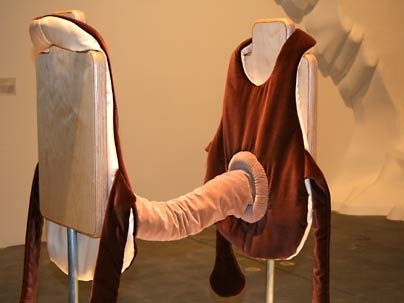"Seamless: Computational Couture," a runway fashion event curated by MIT Media Lab graduate students, will present its second annual collection of technologically experimental clothing at the Museum of Science on Feb. 1 at 7 p.m.
Christine Liu and Nicholas Knouf, graduate students in media arts and sciences, collaborated with Lisa Monrose, director of Brainy Acts at the museum, to gather and present original couture by students from MIT, Rhode Island School of Design, Parsons School of Design and New York University, as well as by other young designers.
According to Liu, the show will display "innovative works that reinvent how we think about clothing and the body. The designs offer new perspectives on the deep, creative resonance among the art, technology and fashion communities."
Knouf said, "We want to showcase an alternative view of the future of fashion, one that combines technology and clothing in an engaging and aesthetically pleasing way."
Chris Csikszentmih��lyi, the Muriel R. Cooper Career Development Professor of Media Arts and Sciences and head of the Computing Culture Group at the MIT Media Lab, is the "Seamless" master of ceremonies. Lars Blackmore of MIT Dance Mix Coalition will provide music.
Featured works by MIT designers include:
��� "Exhausted," by Marisa Jahn, graduate student in architecture and planning. This garment is a pair of vests joined by a bellows-like tube. Individuals wear the vests while facing each other, with the bellows contracted. As they pull away, their movements generate sound. When fully extended, the bellows reveal the word "exhaust." As the pair embraces, the air is expelled.
��� "The Gather Skirt," by Kate James, graduate student in architecture and planning. This is a skirt made entirely of pockets with magnets mounted on the bottom layers. It gathers metal scraps and remnants -- a must for the urban scavenger.
��� "Muk.luk.flux," by Amanda Parkes, graduate student in media arts and sciences. These boots change shape based on the speed of the wearer. An accelerometer inside tracks the user's speed and expands the boots.
��� "DarkWatch," by John Rothenberg, graduate student in architecture and planning. This gadget counts dark intervals of time. Rothenberg programmed his "darkWatch" to cycle every 261 seconds -- the rate at which people are dying in Darfur. "Keeping this information close to our bodies can be both a personal call to action and a form of public protest," he said.
��� "Arabiia," by Ayah Bdeir, graduate student in media arts and sciences. This convertible outfit reflects opposing images of the Arab woman -- the sexualized belly dancer and the veiled woman. Equipped with two servo-motors and a switch, it enables the wearer to flip between stereotypes.
��� "Taptap," by Leonardo Bonanni, graduate student in media arts and sciences. This is a wearable system to record and play back touch to remind the wearer of a loved one. In scarf form, it is made of two layers of felt -- a gray layer that faces the public and a warm pink layer that contains modules that "touch" the wearer's head. "Simply place the modules where you want to feel the touch and wrap the scarf tightly," said Bonanni.
��� "Endangered Senses," by Gemma Shusterman, graduate student in media arts and sciences. This costume is designed to empathize with elephants' senses. It has telescoping sleeves that connect to the floor and contains a sensor to pick up vibrations that elephants perceive. That signal is sent to a synthesizer and broadcast via amplified speakers so humans can hear it.
Tickets for "Seamless: Computational Couture" cost $10 and include a dessert reception. Advance purchase is strongly recommended. Tickets may be purchased by phone at (617) 723-2500, or online at www.mos.org/art.
For more information, e-mail seamless-producers@sigtronica.org.
A version of this article appeared in MIT Tech Talk on February 1, 2006 (download PDF).






